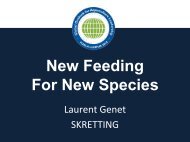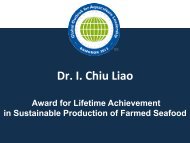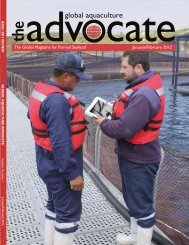May/June 2010 - Global Aquaculture Alliance
May/June 2010 - Global Aquaculture Alliance
May/June 2010 - Global Aquaculture Alliance
You also want an ePaper? Increase the reach of your titles
YUMPU automatically turns print PDFs into web optimized ePapers that Google loves.
innovation<br />
Two -Stage Selection Key<br />
For Fast Shrimp Growth In Mexico<br />
Larval Growth<br />
300 Families<br />
(2 Replicates)<br />
Low Inbreeding<br />
Mating<br />
Broodstock<br />
Growth,<br />
Maturation<br />
6 Families<br />
(Commercial Line)<br />
Figure 1. Two-stage breeding program at Maricultura del Pacífico.<br />
Héctor Castillo-Juárez, Ph.D.<br />
Mejoramiento Genético Animal y Biometría<br />
Departamento de Producción Agrícola y Animal<br />
Universidad Autónoma<br />
Metropolitana, Unidad Xochimilco<br />
Calzada del Hueso 1100<br />
México 04960 D.F. México<br />
hcjuarez@correo.xoc.uam.m<br />
Hugo. H. Montaldo, Ph.D.<br />
Universidad Nacional Autónoma de México<br />
Gabriel R. Campos-Montes, Ph.D.<br />
Maricultura del Pacífico, S.A. de C.V.<br />
Mazatlán, Sinaloa, México<br />
Genetic<br />
Evaluation at<br />
28 Days<br />
Crosses,<br />
Mass<br />
Selection<br />
Summary:<br />
The largest shrimp hatchery in Mexico has implemented<br />
a two-stage selection program based on body weight at<br />
28 days of age and and body weight at 130 days. This<br />
approach increases the genetic gain for growth at harvesting<br />
age, since body weight at 28 days is highly correlated<br />
with body weight at 130 days. After successive<br />
family selections, the top 5 to 10% of the shrimp produce<br />
a new generation of 300 families for the next year.<br />
Growth In Cages<br />
150 Families<br />
within-Family<br />
Selection<br />
70 Families<br />
Growth<br />
Growth<br />
Until<br />
Tagging<br />
Genetic<br />
Evaluation at<br />
130 Days<br />
Ranking<br />
(BVs)<br />
COMMERCIAL<br />
PRODUCTION<br />
Selection Of<br />
Broodstock<br />
(Commercial)<br />
Mexican shrimp producers face growing international competition<br />
and hence have improved their management practices<br />
over time. They demand healthy, high-quality, fast-growing<br />
shrimp postlarvae for their commercial ponds. Mexican hatcheries<br />
therefore face challenges to design better breeding programs<br />
for the shrimp industry.<br />
At Maricultura del Pacífico, the largest shrimp hatchery in<br />
Mexico, recent changes for better breeding included the implementation<br />
of a two-stage selection program based on body<br />
weight at 28 days of age and growth and body weight at 130<br />
days of age. This two-step approach increases the genetic gain<br />
for growth at harvesting age, since body weight at 28 days is<br />
highly correlated with body weight at 130 days of age.<br />
The possibility of increasing the number of shrimp families<br />
to be tested in selection experiments for growth performance at<br />
early ages allows the selection of the best 150 families out of 300<br />
at each cycle. Although at this early stage, the family selection<br />
emphasis is based on growth and predicted breeding values, families<br />
with relatively low survival PVBs are discarded.<br />
Initial Selection<br />
Selection of body weight at 28 days is based on an animal<br />
model and best linear unbiased prediction (BLUP) methodology.<br />
BLUP is a method of statistical analysis in which numerical<br />
scores are given to traits and compiled as predictions for future<br />
use. The model includes random environmental and animal<br />
effects, plus the fixed effects associated with the hatchery production<br />
process, such as position in the larvae production area.<br />
Once the 150 families are selected, the two family tank replicates<br />
are mixed. When they reach approximately 2-g body<br />
weight, 450 postlarvae (PL) from every family are marked with<br />
elastomer tags in order to be identified in the pond performance<br />
tests, while the rest of the postlarvae are kept under environmentally<br />
controlled conditions with maximized sanitation at the<br />
genetic nucleus of the hatchery.<br />
Elastomerized postlarvae from the selected families are then<br />
seeded in three ponds with different management representing<br />
three common management systems found in Mexico. Densities<br />
of 10 and 30 PL/m 2 are used in sandy soil, while 180 PL/m 2 are<br />
used with concrete bottoms. A performance test for body weight<br />
after 90 days is carried out, and hence, at approximately 130 days<br />
of age, each shrimp of every family is individually weighed.<br />
Data Analysis<br />
Data from this process is then analyzed for body weight and<br />
survival using a model that includes the animal effect, maternal<br />
effect and fixed effects of pond management and age at harvesting<br />
as a covariate, since small age differences between families associated<br />
with the production process in the hatchery need to be adjusted.<br />
Again, BLUP is used as the evaluation method. At this second<br />
stage, a selection index that includes body weight (8/9) and<br />
survival (1/9) is used to select the best 70 families out of the 150<br />
that entered the experiment.<br />
In the meantime, the full siblings of the 150 families kept in<br />
the genetic nucleus have passed through an additional mass<br />
within-family selection process that keeps approximately the top<br />
30% of each family. This additional step guarantees that only the<br />
best animals within family are chosen based on growth, and the<br />
best families are selected.<br />
After the best 70 families are selected, the top 5 to 10% of<br />
these shrimp are selected in another mass selection. These animals<br />
will produce the new generation of 300 families for the next<br />
year. This process repeats year after year.<br />
The annual generation of the 300 families minimizes<br />
inbreeding by controlling the mating process using artificial<br />
insemination with two females per male. It is also based on the<br />
relationships between potential mates from the pedigree. The<br />
actual inbreeding average of the population in the genetic<br />
nucleus is 3.31%<br />
Commercial, Conservation Lines<br />
The best four to six families from this second stage are also<br />
used to establish the commercial line of the hatchery. This process<br />
consists of mating two sets of families with the lowest additive<br />
relationship, ideally a family ranked first with a family<br />
ranked fourth, and a family ranked second with a family ranked<br />
third.<br />
Animals from these two crosses are mass selected using the<br />
top 10%, and the two lines are then crossed to yield the commercial<br />
line. Figure 1 summarizes the breeding program of Maricultura<br />
del Pacífico.<br />
The hatchery also has a second line to preserve genetic variation.<br />
The selection index in this line gives a relatively higher<br />
weight to survival (1/5) compared to the growth line (1/9). The<br />
line started in 2007, and some experiments within it regarding<br />
the effects of inbreeding on growth and survival are in the process<br />
of being analyzed. Families from this conservation line will<br />
likely be considered for growth to restore lost genetic variation<br />
when necessary in the future.<br />
78 <strong>May</strong>/<strong>June</strong> <strong>2010</strong> global aquaculture advocate global aquaculture advocate <strong>May</strong>/<strong>June</strong> <strong>2010</strong> 79





